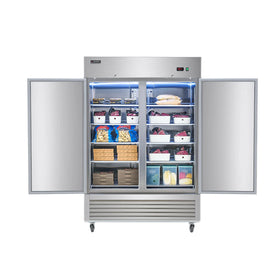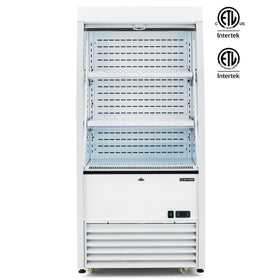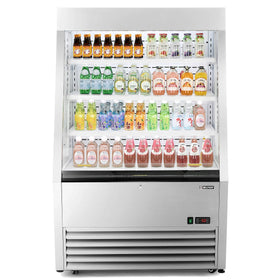Commercial refrigerators are at the core of everything that goes on in a restaurant or any food business, and managers are often on the search for top-quality models that can serve long term without breaking down or gradually becoming inefficient. However, ensuring the longevity of a commercial refrigerator goes beyond quality; frequent and proper maintenance makes a huge difference. Proper maintenance helps prevent costly repairs, reduces energy consumption, and ensures food products remain safe and fresh. Here are the top 7 maintenance tips to keep your commercial refrigerator in optimal condition.
CLEAN REGULARLY
A commercial refrigerator that is regularly cleaned performs much better and lasts longer. Dirt, dust, and food particles should not be allowed to accumulate in the refrigerator as they can obstruct airflow and strain the compressor, leading to inefficiencies and potential breakdowns. Pay attention to the following when cleaning your commercial refrigerator:
- Start from the Inside: Remove all food items and shelves from the inside of the refrigerator. Then, use a mixture of warm water and mild detergent to thoroughly wipe the interior surfaces. Finally, rinse with clean water and dry with a soft cloth.
- Don't forget the exterior: Many people make the mistake of thinking that the exterior of a refrigerator does not need cleaning. Get a damp cloth and some detergent and wipe down the front door, sides, handles, and even the back. Pay special attention to door seals and handles as they are usually prone to attracting dirt and dust.
- And the Condenser Coils: Check the back for condenser coils. This string of coils is the outlet through which the refrigerant releases the heat absorbed from inside. Use a vacuum or brush to gently clean the coils, ensuring they are free from obstructions, dust, or debris.
CHECK AND MAINTAIN TEMPERATURE SETTINGS
The refrigerator is designed to keep food cold, and for that, the temperature within has to be constant. When the temperature fluctuates or is set incorrectly, the food inside goes bad, and energy consumption increases significantly. Maintaining correct and constant temperature settings is essential to ensuring food safety and energy efficiency.
How to Check and Maintain Temperature Settings
- Make Sure the Temperature is Set Right: Ensure the refrigerator is set to the manufacturer’s recommended temperature. This is usually the optimal temperature for the kinds of food the refrigerator is meant to store. For most commercial refrigerators, this is between 35°F and 38°F.
- Conduct Regular Temperature Checks: A reliable thermometer is a must-have for anyone who owns or operates a commercial refrigerator. Use the thermometer to check the internal temperature regularly. Any deviation from the set temperature is an indication that might indicate a problem with the cooling system.
- Adjust Thermostat Settings: The thermostat monitors the temperature within the refrigerator and ensures that it stays within a set range. If you notice irregular fluctuations, adjust the thermostat settings accordingly and monitor for consistency.
- Inspect Door Seals And Gaskets: The doors of commercial refrigerators are often lined with door seals. The seals are important because they prevent cool air from escaping, thereby playing a crucial role in maintaining the refrigerator's internal temperature. If the seals get damaged or worn, cold air escapes, exposing the food to risk and increasing energy consumption.
How to Inspect Door Seals and Gadgets
- Visual Inspection: Regularly inspect the door seals and gaskets closely for cracks, tears, or signs of wear.
- Clean the Seals: Clean the seals with a mild detergent and warm water to remove any food particles or debris.
- Replace if Necessary: If you find any damage, replace the seals promptly to ensure a tight seal.
- Ensure Proper Airflow: Cold air must circulate to every part of the interior for the refrigerator to work. When vents are blocked, shelves are overcrowded, airflow is blocked or hindered, and the results are spectacularly unpleasant. Some areas of the refrigerator may become too cold, leading to freezing, while others become too warm, causing food to spoil. In a commercial establishment, fewer things could be worse.
How to Ensure Proper Airflow
- Avoid Overloading the Refrigerator: Stop filling the refrigerator when it reaches full capacity. Also, leave space between items and shelves to allow air to circulate freely.
- Keep Vents Clear: Ensure that vents inside the refrigerator are not blocked by food items or containers.
- Arrange Shelves Appropriately: Arrange shelves and items to facilitate optimal airflow, ensuring consistent cooling throughout the unit.
- Regularly Defrost The Unit: Ice buildup in a refrigerator refers to the accumulation of ice on various components inside the appliance, mostly the freezer compartment or around the evaporator coils. When ice buildup occurs in a commercial refrigerator, performance is significantly inhibited, and the compressor is put under additional strain. Regularly defrost your refrigerator to prevent excessive ice accumulation and maintain optimal performance.
How to Defrost a Commercial Refrigerator
- Manual Defrosting: Some commercial refrigerator models must be defrosted manually. If your unit requires manual defrosting, schedule regular defrosting sessions. To defrost, remove all food items, unplug the refrigerator, and allow the ice to melt. Clean and dry the interior before restarting.
- Automatic Defrost: For units with automatic defrosting, ensure the defrost cycle functions correctly. Check for signs of ice buildup and troubleshoot any issues promptly.
- Check And Maintain The Compressor: The compressor is the heart of your commercial refrigerator: it takes in low-pressure, low-temperature refrigerant vapor from the evaporator. It compresses it into a high-pressure, high-temperature vapor. Keeping the compressor in good working condition is vital for the unit's overall performance and longevity.
How to Maintain the Compressor
- Listen for Unusual Noises: Strange sounds such as unusually loud or persistent humming or buzzing noises could indicate a problem that needs immediate attention. Pay attention to any unusual noises coming from the compressor.
- Clean Surrounding Areas: Ensure the area around the compressor is clean and free from dust and debris. This prevents overheating and ensures efficient operation.
- Professional Maintenance: Schedule regular maintenance checks with a technician to inspect and service the compressor and other critical components.
- Schedule Regular Professional Maintenance: While regular in-house maintenance is time-saving, efficient, and essential, professional servicing ensures that all components of your commercial refrigerator are thoroughly inspected and maintained. Professionals can identify and address potential issues before they escalate.
When to Schedule Regular Professional Maintenance
- Bi-Annual Checks: Schedule professional maintenance at least twice a year. This includes a thorough inspection, cleaning, and servicing of all components.
- Detailed Reports: Request detailed reports from the technician outlining the refrigerator's condition and any recommended repairs or replacements.
- Follow Recommendations: Act on the technician’s recommendations promptly to prevent minor issues from becoming major problems.
CHECK OUT WILPREP
By following these seven maintenance tips, you can ensure that your refrigerator remains in optimal condition, reduce the risk of breakdowns, and extend its lifespan. The first step to ensuring longevity is to buy a top-quality refrigerator; you will need a trustworthy supplier. Wilprep’s Kitchen is a well-established supplier of commercial kitchen equipment, including refrigerators, ovens, food warmers, and other related equipment for thousands of restaurants and food service businesses worldwide. As a market leader, Wilprep supplies refrigerators of varying sizes and models to meet the needs of diverse businesses. From display refrigerators to reach-in refrigerators, Wilprep has it all. Wilprep’s equipment are certified for safety, and a dedicated customer service team is always available to ensure you acquire not only the best product but also the best services. Check out Wilprep for more.









